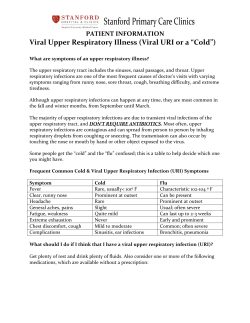
Infection Control Policy and Procedure Manual
Infection Prevention and Control Policy and Procedure Manual Section 3c Viral Respiratory Panel (VRP) and Respiratory Illness Isolation Guidelines Reviewed/Revised: Written and Approved: 03/06 Reviewed and Revised: 11/09 Reviewed and Revised: 11/10 Reviewed and Revised: 04/11 Reviewed and revised: 12/12 Page 1 of 2 Purpose: Respiratory infections, particularly those caused by viruses, may be transmitted from person to person in many settings. To identify patients suspected of having a respiratory illness attributed to an infectious cause and place them on appropriate isolation while in the hospital to prevent nosocomial spread. To prevent the transmission of common respiratory tract infections among patients, employees, and visitors. Rationale: Viral Respiratory Panels (VRPs) are respiratory cultures that detect respiratory diseases such as: Adenovirus Human Metapneumovirus Influenza A & B Parainfluenza 1, 2, and 3 These infections may sometimes result in pneumococcal infections in young children and patients with compromised immune systems. Frequent hand hygiene is critical in preventing the spread of these infections. Transmission: Respiratory tract infections are spread via close contact of an infected individual’s respiratory secretions or contact with contaminated surfaces or objects. Respiratory illnesses may occur with contact of mucous membranes such as, the eyes, mouth, or nose, and possibly through the inhalation of droplets generated by a sneeze or cough. Isolation: In addition to standard precautions, all patients with an ordered VRP should be placed on contact and droplet precautions. Policy: To limit the spread of viral respiratory infections in the hospital and to protect staff and patients from inadvertent exposure to viral respiratory illnesses, patients admitted as an inpatient with presumed viral respiratory infections will be placed on both Contact Precautions and Droplet Precautions. This will continue until the testing such as a viral respiratory panel (VRP) result is final. Initiate Contact Precautions (gown and gloves) before entering the patient’s room. Initiate Droplet Precautions (surgical/procedure mask) before entering the patient’s room. A written order from an attending physician and/or resident is necessary to isolate these patients. (It is permissible to isolate the patient and obtain a telephone order within 24 hours of isolation.) A written order is also needed to discontinue the contact isolation. This policy does not apply to diseases that require airborne isolation (e.g. Varicella, SARS, or TB). Viral Respiratory Panels should be obtained during the first 72 hours of admission. Perform frequent hand hygiene before and after direct contact. Infection Prevention and Control Policy and Procedure Manual Section 3c Viral Respiratory Panel (VRP) and Respiratory Illness Isolation Guidelines Reviewed/Revised: Written and Approved: 03/06 Reviewed and Revised: 11/09 Reviewed and Revised: 11/10 Reviewed and Revised: 04/11 Reviewed and revised: 12/12 Page 2 of 2 Procedure: For the purpose of this policy, respiratory symptoms will be defined as: cough, wheezing, sore throat and/or rhinorrhea (runny nose) attributed to an infectious cause. This includes children with bronchiolitis or suspected viral pneumonia and all children for whom a VRP is ordered. All patients with a suspected viral cause for respiratory symptoms will be placed on both Contact and Droplet Precautions upon admission to the hospital. When pertussis is suspected or a Pertussis PCR is ordered the patient should be placed on Droplet Precautions. Patients/parents will be informed of the purpose of isolation. Patients should be masked, if appropriate when transported from room to other diagnostic or therapeutic care center within CHS Once patients are evaluated, the patient will remain on isolation until the resolution of their symptoms or the recommended treatment is complete. For example, patients with Pertussis may be removed from isolation after 5 days of antibiotic treatment. Employees involved in cough producing procedures (such as suctioning) should wear eye protection in addition to gloves, gown and mask. Negative pressure rooms are not necessary. Dedicate supplies to the room or disinfect before removing them from the patients room: stethoscope, scales, thermometers, pens, etc. Environmental surfaces and equipment will be cleaned with a hospital approved cleaning solution, as per manufacturers’ instructions. Employees: Employees with known or suspected respiratory infections will be managed according to the Employees with Communicable Diseases Policy. Flu vaccinations are available and recommended to all healthcare workers before flu season to minimize the risk of acquiring a respiratory infection. References: Centers for Disease Control and Prevention (2003), Guidelines for Preventing HealthcareAssociated Pneumonia, MMWR 2004; 53(RRO3): 1-36 “Report of the Committee on Infectious Diseases,” 29th Edition, The American Academy of Pediatrics, 2012
© Copyright 2025











